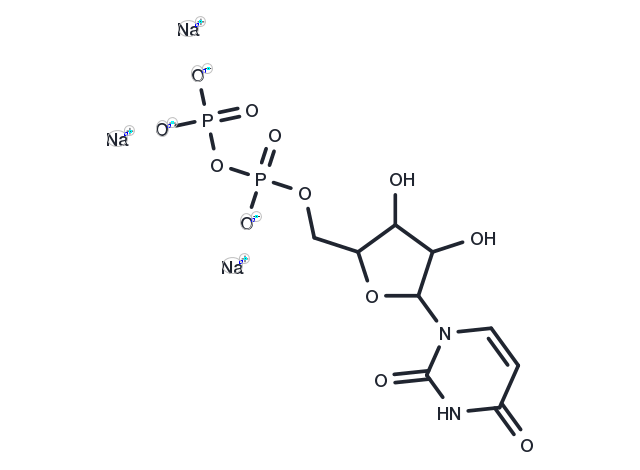Powder: -20°C for 3 years | In solvent: -80°C for 1 year


Uridine 5'-diphosphate sodium salt is a selective native agonist of the P2Y6 receptor (EC50: 300 nM; pEC50: 6.52), and also is a potent antagonist of P2Y14 (pEC50: 7.28).

| Pack Size | Availability | Price/USD | Quantity |
|---|---|---|---|
| 100 mg | 5 days | Inquiry | |
| 500 mg | 5 days | Inquiry |
| Description | Uridine 5'-diphosphate sodium salt is a selective native agonist of the P2Y6 receptor (EC50: 300 nM; pEC50: 6.52), and also is a potent antagonist of P2Y14 (pEC50: 7.28). |
| In vitro | microglial CCL2 and CCL3 mRNA expression significantly induced by Uridine 5'-diphosphate sodium salt (100 μM; for 15 min)[2]. Uridine 5'-diphosphate sodium salt (100 μM; 3 hours) induces chemokine expression in microglia[2]. Uridine 5'-diphosphate sodium salt (100 μM; 0.5, 1, 3, 6 12 hours) induces expression of mRNA encoding CCL2 and CCL3 within 30 min, and such expression reaches maximal levels at 1 h, returning to basal levels at 3-12 h[2]. UDP (10, 100, 1000 μM; 3 hours) induces a concentration-dependent increase in the expression of chemokines at both the mRNA and protein level[2]. Activation of NFATc1 and NFATc2 in microglia induced by Uridine 5'-diphosphate sodium salt (100 μM; for 15 min) [2]. |
| Molecular Weight | 470.106 |
| Formula | C9H11N2Na3O12P2 |
| CAS No. | 21931-53-3 |
Powder: -20°C for 3 years | In solvent: -80°C for 1 year
You can also refer to dose conversion for different animals. More
bottom
Please see Inhibitor Handling Instructions for more frequently ask questions. Topics include: how to prepare stock solutions, how to store products, and cautions on cell-based assays & animal experiments, etc.
Uridine 5'-diphosphate sodium salt 21931-53-3 Others Uridine 5'diphosphate sodium salt Uridine 5' diphosphate sodium salt Uridine 5'-diphosphate sodium inhibitor inhibit
